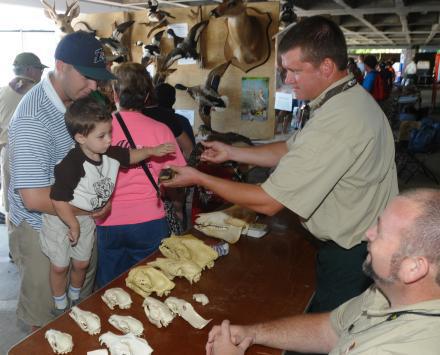|
White-nose syndrome has killed bats by the millions, and Georgia’s bats aren’t going unscathed. The disease first reported in New York in 2006-2007 turned up here in 2013. The following winter, DNR surveys documented a 36-percent decline in known bat hibernacula in north Georgia.
Money from the Georgia Nongame Wildlife Conservation Fund, which the eagle and hummingbird plates support, is being used to match a State Wildlife Grant to monitor white-nose and raise awareness among cavers and other cave users. (While bat-to-bat transmission is considered the primary path for spreading the fungus, humans can introduce it by carrying contaminated gear into “clean” caves.)
Bat biologist Trina Morris of the Nongame Conservation Section spent last weekend working the TAG Fall Cave-in, an annual event that draws cavers from Georgia, Alabama and Tennessee to Lookout Mountain. Her goal: Continue talking with cavers, cave owners and conservation groups to raise awareness about limiting winter trips into caves and following decontamination protocols for disinfecting clothes and gear, all part of DNR’s white-nose response plan.
And this winter, Morris will return to the caves to again monitor the disease's devastating impact.
WNS in Georgia
Our thanks …
To those who took part in the wildlife plates survey in the Sept. 29 issue. We’ve picked an eagle tag winner for this round, but stay tuned: We plan to give away another eagle plate later this fall!
Back to top.
Noteworthy
A “new” right whale calf has been documented off Cape Cod, Massachusetts. In May, researchers conducting an aerial survey spotted the North Atlantic right whale calf with an adult female that had not been seen with young earlier that winter in the Southeast, the species’ central calving grounds. The addition bumps the year’s calf total to 11. While still only about half the annual average (“Slow year for right whales,” April 8), the find is a morale-booster for scientists monitoring the highly imperiled whales. It’s not known where or when the calf was born. But the mother, nicknamed “Baldy,” was first seen with a calf in April 1974, meaning she’s probably at least 50 years old. This is her ninth known calf.

While North Atlantic right whales will be arriving off Georgia’s coast by December, the Right Whale Festival in Jacksonville Beach, Fla., on Nov. 15 will kick off the calving season. The free event includes a beach cleanup, runs, music, kids’ activities and vendors, all geared to raising awareness about right whales and the threats they face, such as ship strikes and entanglement in commercial fishing gear.
Twenty-seven federally protected species are due “five-year reviews” from the U.S. Fish and Wildlife Service to make sure their classifications under the Endangered Species Act are correct. Species found in Georgia include the endangered reticulated flatwoods salamander and southern acornshell, triangular kidneyshell, Coosa moccasinshell, southern pigtoe mussels, and the threatened frosted flatwoods salamander and Alabama moccasinshell and fine-lined pocketbook mussels.
Georgia landowners will only have to sign up once for Natural Resources Conservation Service’s Environmental Quality Incentives Program and special conservation options such as Working Lands for Wildlife and the Longleaf Pine Initiative. The simplified application is aimed at making it easier for constituents to understand and participate in agency programs. The deadline to apply is Dec. 19.
Florida’s loggerhead sea turtle nest totals remained high this summer and leatherback turtle nesting reached a new record for the Sunshine State. Though nest counts for loggerheads, the Southeast’s primary nesting sea turtle, vary annually, the overall trend in Florida, as in Georgia, is positive, according to the Florida Fish and Wildlife Conservation Commission.
Names in the news: The South Atlantic Fishery Management Council Ranger has named DNR Ranger 1st Class David Brady its 2013 Law Enforcement Officer of the Year. Brady, who often patrols offshore as captain of the Law Enforcement Division’s SAFE vessel and a Contender patrol boat, led or took part in five federal fisheries cases referred to NOAA Fisheries the previous year. A new book by Ron Lance, "Haws: A guide to hawthorns of the southeastern United States," provides a detailed reference to the 62 hawthorn species and 144 subspecific taxa and hybrids known to occur in the region. Lance, a longtime naturalist, is a biologist and land manager with North American Land Trust.
Coming up:
Oct. 16-18 – 36th annual Gopher Tortoise Council Conference, Chehaw Park, Albany.
Oct. 21-24 – 10th Biennial Longleaf Conference, Ninth Eastern Native Grass Symposium and National Prescribed Fire Council meeting, Mobile, Ala.
Oct. 28 – Land Manager’s Lunch: The Safe Harbor Program and Southern Quail Lands, Tall Timbers Research Station and Land Conservancy, Tallahassee, Fla. Register by Oct. 24. Lisa Baggett, (850) 893-4153 (ext. 241).
Nov. 7-9 – Fall BOW program (Becoming an Outdoors-Woman), Charlie Elliott Wildlife Center, Mansfield.
Nov. 15 – Right Whale Festival, Sea Walk Pavilion, Jacksonville Beach, Fla.
Back to top.
|
Headlines
"UGA to study endangered Atlantic sturgeon in three Georgia rivers," UGA Today
"Ohoopee Dunes WMA adds new features," The Forest-Blade (Swainsboro)
(+video) "Rare peregrine falcon rescued in Moultrie," WALB-TV (Albany)
"Are Montana’s invasive fish in for a shock?" Wildlife Conservation Society
(+video) "Scrambling birds’ brains: Could this toxic algae offer clues to human diseases?" Environmental Health News (citing DNR's Jim Ozier)
"Q&A with Henry Paulson: dialogues on the environment," Mark's Desk (blog by The Nature Conservancy CEO and President Mark Tercek)
"Eastern hemlocks that have survived insect infestation have a story to tell," Virginia Tech
"Box turtles will be hatching soon in Savannah, rest of Georgia," Savannah Morning News (column by Dirk J. Stevenson of The Orianne Society)
(+video) "Videos hint at why tree bats may die at wind turbines," ScienceNews (citing study in the Proceedings of the National Academy of Sciences).
"Georgia Southwestern University group hopes to help Muckalee crayfish fend off invasive species," The Albany Herald
"Fishing club supports environmental education (at DNR's Arrowhead Environmental Education Center)," The Atlanta Journal-Constitution
"Goats better than chemicals for curbing invasive marsh grass," Duke University
"Conservation efforts help keep Georgia aster off endangered species list," Southeast Green
Video
“Talking Nature Tuesday” with Berkeley Boone, DNR Charlie Elliott Wildlife Center
"Hawk vs. drone," The Washington Post
"The North American Model of Wildlife Conservation," Boone and Crockett Club
"Alligator nest hatching on Jekyll Island," Applied Wildlife Conservation Lab
Back to top.
Parting shot
 The 20th annual CoastFest drew a crowd of about 9,500 to DNR Coastal
Regional Headquarters in Brunswick on Saturday. Entertainment varied from
a bluegrass band to reptiles and raptors, with special exhibits such as walk-thru
butterfly garden and a 4,000-gallon saltwater aquarium provided by funding from
the Georgia Natural Resources Foundation. The 2015 CoastFest is set for Oct. 3.
Credits
** Masthead: Scarlet calamint flowers. Alan Cressler
** Sandhill rosemary at Ohoopee Dunes. Marc Del Santro
** Scarlet calamint. Alan Cressler
** Black and yellow Argiope spider. Terry W. Johnson
** Barred owl. Josiah Lavender
** DNR's Trina Morris conducting a cave bats survey. Pete Pattavina/U.S. Fish and Wildlife Service
** Learning about wildlife, including a young alligator, at the DNR Game Management Section booth at CoastFest. Nancy Butler/Coastal Resources Division
Back to top.
|